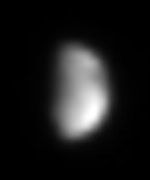
Image credit: NASA/JPL/Space Science Institute
This Cassini image hints at the split personality of Saturn?s 1436 kilometer (892 mile)-wide moon Iapetus. The Voyager spacecraft first imaged this curious yin/yang moon, with its light and dark hemispheres. The dark hemisphere is the side of Iapetus that leads in its orbit. In this view, both light and dark areas are visible.
The image was taken in visible light with the narrow angle camera on May 23, 2004, from a distance of 20.2 million kilometers (12.5 million miles) from Iapetus. The image scale is 12 kilometers (75 miles) per pixel. The image was magnified to aid visibility.
The Cassini-Huygens mission is a cooperative project of NASA, the European Space Agency and the Italian Space Agency. The Jet Propulsion Laboratory, a division of the California Institute of Technology in Pasadena, manages the Cassini-Huygens mission for NASA’s Office of Space Science, Washington, D.C. The imaging team is based at the Space Science Institute, Boulder, Colorado.
For more information about the Cassini-Huygens mission, visit http://saturn.jpl.nasa.gov and the Cassini imaging team home page, http://ciclops.org.
